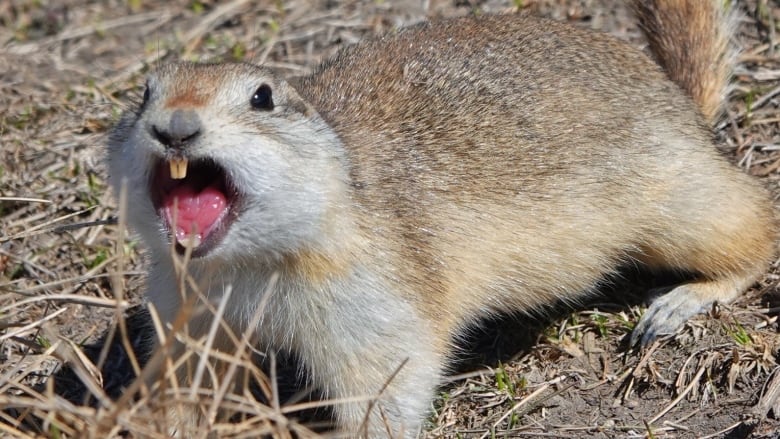Why male 'gophers' start to hibernate mid-summer, a litter may have several dads and other nature facts
Naturalist Brian Keating snapped some pictures of the critters in action on Saturday

Did you know that Alberta's so-called "gophers" aren't actually gophers at all? Or that the males start "hibernating" mid-summer and wake up before the snow melts? Or that the females might give birth to a litter of pups that have multiple dads?
Calgary-based naturalist Brian Keatingshared these and other fascinating facts about the Richardson's ground squirrels popularly referred to as "gophers" in Alberta when he spoke with CBC Calgary'sThe Homestretchon Monday.
Keating, who has a new Going Wild website,said theappearance of the gophers is a sure sign of spring and urgedAlbertans to head to the park to watch these little critters look for a mate sharing some tips so people know what they're watching.
(This interview has been edited for clarity and length.)
Q:Why do you think gopher watching is such a great COVID hobby?
A:You can get out of your ownCOVID-thinking head, and get into the minds and views of gophers running around. It's a fantastic way to to just absorb,I think, one of the iconic prairie species that is common in the city.
I bet you on every quadrant in Calgary, there's a good gopher watching location.

Q: Where have you gone to watch gophers?
A: I took my wife out for a gopher-watching date and it was it was a big hit.
We biked up to the Max Bell Centre, and that's the chunk of land that's sandwiched between the Deerfoot Trail and Barlow Trail.
They've just recently come out of hibernation. Basically,they tell you that spring is really here despite what's going on outside right now.
Q: Can you tell us more about the southern Alberta gopher?
A: Our prairie gopher, [whose] official name is the Richardson's ground squirrel, belong to the squirrel family. Actually, all of them belong to the squirrel family. And that includes tree squirrels, ground squirrels, chipmunks, marmots, flying squirrels, prairie dogs and a bunch of others. There's some 300 species of squirrels worldwide.

Q: So the way I understand the role they play is the gophers eat the grass and then everything out there in the prairies that eats meat, eats the gopher. Is thatbasically the way it works?
A:All of these creatures are ecosystem managersand our Richardson's ground squirrelis incredibly successful, with numbers that are high enough to turn the soil over, to keep the nutrients moving. As well, their holes and burrows provide incredible drainage opportunities for rain and floodwaters.
They're primary consumerswith the result that they're food for many,including badgers, weasels, hawks and snakes.
Q: Tell us about the life and times of the Richardson's ground squirrel?
A: The majority of their lives, they're out of sight from us down in those chambers and tunnels.
And when they do come above the ground, it's usually just to eat and to meet. Of course, the problem is they get into trouble when they're above ground, especially if they're near farms.

Q: Can you tell me more about how they hibernate?
A: Males will hibernate early. It's called estivation. They actually go to sleep in midsummer and they store a bunch of grain and seeds underground.
The females don't go into hibernation until later on in the summer, after she's weaned her offspring. And then the youngsters are the last ones to go underground.

Q: What about their breeding cycle?
A: When males come out oftheir hibernation for the final time, they actually come outwhen itstill can be quite cold above ground.
Research indicated that they actually wake up quite a long time before the snow disappears. Anddown there, they eat the seeds from the year before.
The males emerge from hibernation, which they're doing right now, and they're gaining weight. They're going to wait for females to start emerging, which should happen within the next couple of weeks.
And of course, at this time of the year, when the males come out, they start to battle other males to acquire as much terrestrial landscape as possible, waiting for those females to come up.

Q: And what about the females?
A:When the females come out, the first thing the males do is try to breed those females. And as the breeding goes on, that's when the aggressive behaviour becomes really significant. And the males will actually bite each other significantly.
It actually seems that the female stimulates fighting between males, which may be part of her angle.
She may want to see those males fight so the males prove which ones are eventually going to impregnate her.
At the end of the day, though, she may mate up with up to four males. And that means that several of the five to eight youngsters that are born in about three weeks after they mate will have several dads.
So I guess that just makes sure that a good genetic mix is secured by her.
For more fascinating stories about Alberta's wildlife from naturalist Brian Keating, visit hiswebsiteand check out these stories:
With files from CBC Calgary'sThe Homestretch












_(720p).jpg)


 OFFICIAL HD MUSIC VIDEO.jpg)
.jpg)



























































































